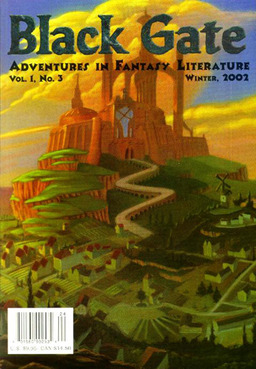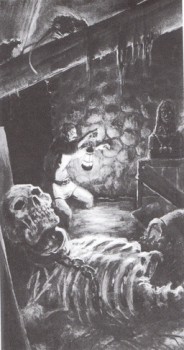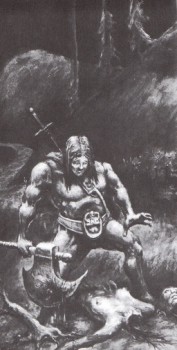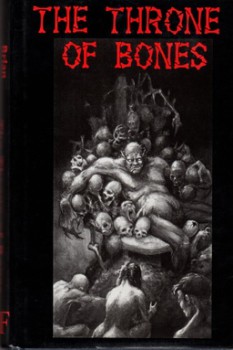A World Mottled With Decay: The Throne of Bones by Brian McNaughton
For all their laughter, ghouls are a dull lot. Hunger is the fire in which they burn, and it burns hotter than the hunger for power over men or for the knowledge of the gods in a crazed mortal. It vaporizes delicacy and leaves behind a only a slag of anger and lust. They see their fellows as impediments to feeding, to be mauled and shrieked at when the mourners go home.
— from “Meryphillia”
The late Brian McNaughton’s 1997 collection The Throne of Bones is a book I want to on one hand praise and with the other hold it away from myself with a pair of iron tongs. It contains some of the best writing I have ever read in fantasy; by turns tense, dark, grimly funny, and occasionally majestic. And it’s set in a vivid world, parts of which will haunt me for a long time.
On the other hand, many of the characters are by far the most despicable I’ve ever met and their actions among the vilest put to paper. Lots of the characters’ actions are motivated by sexual appetites that are many things — mostly disturbing — but never even remotely erotic. So if this review leaves you curious about McNaughton’s work, be warned: while it’s not sadistic or very frightening, it is strong stuff.
The Throne of Bones contains nine short stories and the novella, “Throne of Bones” itself composed of six intricately intertwined stories. They are set within and on the edges of an old empire slipping into decay: crumbling cities, clashing religious sects, and feuding noble clans. The rich and powerful lead lives of luxury, while the poor live in squalor. Between them a small middle class live in dual fear of the nobility and of falling into poverty.
McNaughton’s world feels very similar to the late Roman Empire. Characters regale the reader with tales of long ago imperial and family glories, and barbarians lurk on the periphery of a society that seems to be in the midst of a slow motion collapse.
The first story, “Ringard and Dendra,” only hints at the weirdness to come in The Throne of Bones. Lord Fariel rides out one day to investigate a stranger whose appearance has been frightening the citizenry. He finds an old man, normal in most ways but extravagantly different in one:
Except for their extraordinary sadness, his eyes were those of an ordinary old man. It was their setting that had upset everyone, tattoos like the patterned skin of a reptile. Not even his eyelids and lips had escaped the needle. The scaly effect was accidental, because the details depicted nothing more sinister than exotic flowers and fungi.
 From this stranger, Fariel learns the true story of the supposed kidnapping of his Aunt Dendra at the hands of the woodcutter’s son, Ringard. For all the baroque grotesqueness that dominates much of this book, McNaughton also kindles startling moments of sorrow. This tale has several of those.
From this stranger, Fariel learns the true story of the supposed kidnapping of his Aunt Dendra at the hands of the woodcutter’s son, Ringard. For all the baroque grotesqueness that dominates much of this book, McNaughton also kindles startling moments of sorrow. This tale has several of those.
Black Gate‘s first Managing Editor, Dave Truesdale, was so enchanted with this tale he suggested it as a reprint for the print magazine and it appeared in Black Gate 3 in January 2002, with all-new art by Richard Corben.
From the sadly affecting “Ringard and Dendra,” McNaughton jumps into the deep end of the pool of human and ghoulish depravity with his six-part novella “The Throne of Bones.” Each section introduces characters struggling through their own adventures, who then reappear later to suffer or inflict further degradations, though this barely hints at the tales’ complexity.
Tying them together is the rise of ghoul king, Vomikron Noxis, and his effort to find and kill his young rival, Polliard. Their struggle comprises the backdrop of ToB and is mostly unbeknownst to the protagonists of the individual stories.
Among the characters in “The Throne of Bones” are a pair of ghoul- and graveyard-obsessed lovers, a terrible grave-robbing rapist, a ghoul who learns she possesses deep maternal instincts, and a ghoulologist. They haunt the tombs, back alleys, and less-than-safe-neighborhoods of the imperial city, Crotalorn. Surrounding them is a constellation of criminals, debased aristocrats and, above all else, ghouls.
Ghouls are the nightmares of every sane person. They are bestial creatures with “coffin-cracking strength.” There’s nothing even remotely romantic about them. For them, all flesh is sustenance. They wallow in the gore and filth of burial pits and around them clings the stink of corruption.

Of their human past only the basest traits remain, though they do have the disturbing power to take on the appearance and memories of those they devour. The unfortunate thing is that there are many utterly insane people willing to interact with them to fulfill their own deviant goals and they account for half the protagonists in the novella.
Tales abound of men driven mad by the sight of them. Insofar as the accounts of such eyewitnesses can be reconciled, their form is vaguely human, though grotesquely long and lank. Different stories add to this the jaws of a hyena, the claws of a sloth and hump of a wild hog, crammed inside a skin whose color and texture evoke comparison with the foulest diseases and even advanced stages of decay.
The closest person to an actual hero appears in “IV: The Doctor’s Tale” in the form of ghoulogist Dr. Porfat of the Anatomical Institute. He is commissioned by his brother-in-law, a high officer in the imperial army, to discover the truth about rumored ghoul attacks. His investigation leads him to the homes of decadent nobles and to the blackest pits beneath Crotalorn. While he doesn’t always act from the noblest of intentions, goaded on as he is by his personal lusts and dreams, he still shines a little light of decency in a putrefying world.
Searching for one of those ignoble nobles, Porfat finds himself in one of Cortalorn’s worst slums:
Weymael Vendren lived, oddly enough, on Vendren Hill, a stronghold of that Tribe long ago, which had since passed into the hands of people with no names at all, or none they wanted known. The rickety tenements stacked onto its steep slope, until they should tumble into the Miraga and float out to sea, held every sort of failure: blind painters, tone-deaf musicians, illiterate writers, generous whores, squeamish cutthroats and honest lawyers. Weymael’s deference to Lady Glypht made him seem a timid Vendren, a fit match for such neighbors.
“The Vendren Worm” is set several generations after the events of “The Throne of Bones.” Asteriel Vendren is epileptic and the holder of the title Inspector of Moats and Trenches. The latter is a sinecure, as “the moats have been dry these two centuries, and the trenches are overgrown lanes”, secured for him by his uncle. What he really is is the writer of dreadfully horrible, yet popular, fictions. Well, what he really is is something else entirely.
“Meryphillia” returns to the subject of ghouls. Meryphillia began her life as a lonely and death-obsessed girl. In death, she became a lonely and life-obsessed ghoul. Somewhere along the way, she falls in love with a poet. Once again, McNaughton proves he is as deft with subtlety as he is with outrageousness.
“Reunion in Cephalune” is similar in nature to Clark Ashton Smith’s “The Empire of the Necromancers,” but its villain has greatly scaled-down ambitions. Instead of seeking to revive an entire dead kingdom, Mobrid Sleith seeks to wake only a few dead in an ancient desert burial site. Unlike Smith’s story, McNaughton’s is funny, though in very creepy ways. The revived are incapable of learning and speak only of the things they last experienced in life. A young prostitute goes on about mirrors and his looks while a gladiator drones on constantly about the killing wounds she inflicted on her opponents.
In “The Art of Tiphytsorn Glocque” a young parricide is consumed by the need to find new colors with which to paint his art. “A Scholar from Sythiphore” is a very short story on the need to pay attention to old stories a little better, particularly when planning to rob from ancient tombs rumored to contain giants.
The last three stories, “Vendriel and Vendreela,” “The Retrograde Necromancer,” and “The Return of Liron Wolfbaiter,” move the stories further forward in time. The empire is a shambles and the city of Crotalorn is “a plain of ashes.” The Vendrens, the most belligerent and vindictive of the noble Tribes, have become the most powerful. From their palace in the city of Fandragord, they rule the land with an iron hand and baleful magics.

Lord Vendriel of “Vendriel and Vendreela” steals the best parts of his realm — be they the healthiest citizen’s heart or Fandragord’s one perfect spring day — to create a consummate companion. As is usually the case with such endeavors, it proves neither simple nor wholly successful.
Then in “The Retrograde Necromancer,” Lord Vendriel tries to secure an audience with the Archimage, whose voice is something he has “never heard.” The only concrete thing known about the Archimage is that he employs childcatchers to deliver all the homeless children of Fandragord to his walled tower. Afer years of failure, Vendriel devises a plan to meet the Archimage using one of his own childcatchers. This story moves from the humorous — and it is very funny — to the sublime in only fourteen pages.
The last and longest of the three is “The Return of Liron Wolfbaiter.” Crondard Sleith was a member of the Fomorian Guard, the old imperial bodyguard. Once, the Fomor were barbarians brought into the empire as mercenaries, but that was centuries ago. Now the Guard is “little more than a marching museum, a costumed choir that sang bloodthirsty songs in a tongue its ranks but dimly understood.”
Following a fateful duel with his foppish commanding officer, Crondard went on the lam to Fandragord, the home city of the ruling Vendren family. Hoping to hide his identity, the erstwhile guard takes the name of an ancient Fomor hero, Liron Wolfbaiter. Liron became famous for supposedly cleaning out the ghouls of Crotalorn after events of the story “Meryphillia.”
Crondard is quickly caught up in literally nightmarish events plaguing the Vendren’s city. To punish a unwanted suitor when he begged her to make all his dreams come true, a sorceress did exactly that. Now his dreams and nightmares are coming true throughout the streets and to the people of Fandragord on a daily basis. Even after the Vendren lord had the man killed, the city is still infested with dreams. The dreamer must be put to rest, but his body has gone missing. Since folklore holds that Fomors are especially attuned to the spiritual realm, Crondard is drafted into the search for the misplaced corpse.
 Brian McNaughton came to my attention with a story called “Ghoulmaster” in the 1996 anthology Miskatonic University and “Meryphillia” in Lovecraft’s Legacy. Both stories stunned me. When I saw an announcement for The Throne of Bones, I bought it at once. I think it’s one of the first books I bought on Amazon. I remember being impressed with it on first read and I still am. The passages I’ve quoted are the barest examples of McNaughton’s style. In his afterword, S.T. Joshi writes, “Clark Ashton Smith, with his delightful mixing of morbidity and humor and his evocative use of language, is the chief influence on McNaughton; but let me say bluntly that, in my humble opinion, McNaughton is a better prose writer than Smith.” For many, I suspect, those are fighting words. And while I often disagree with Joshi, I find myself in agreement with him here.
Brian McNaughton came to my attention with a story called “Ghoulmaster” in the 1996 anthology Miskatonic University and “Meryphillia” in Lovecraft’s Legacy. Both stories stunned me. When I saw an announcement for The Throne of Bones, I bought it at once. I think it’s one of the first books I bought on Amazon. I remember being impressed with it on first read and I still am. The passages I’ve quoted are the barest examples of McNaughton’s style. In his afterword, S.T. Joshi writes, “Clark Ashton Smith, with his delightful mixing of morbidity and humor and his evocative use of language, is the chief influence on McNaughton; but let me say bluntly that, in my humble opinion, McNaughton is a better prose writer than Smith.” For many, I suspect, those are fighting words. And while I often disagree with Joshi, I find myself in agreement with him here.
The thing is, in the nearly twenty years since its publication, I’ve become a little less comfortable with stories that wallow in depravity. There are many places in The Throne of Bones that are just so unpleasant that I really can’t see a justification for them. Call me nuts, but just because an author can write something doesn’t mean it needs to be written. McNaughton’s writing is so powerful he really doesn’t need to rub the reader’s nose in it to make clear how dark and unpleasant his world is. That said, the book isn’t filled with mindless cruelty masquerading as realism. The characters who suffer the most are easily the least innocent.
The Throne of Bones is a challenging book and I can only recommend it with reservations. Every emotional or prosodic height it climbs is matched by a bath in a cesspit. It’s a strange book, one I suspect will be read and remembered for a long time by connoisseurs of fantastic fiction, but I think the deep darkness of much of its contents will prevent it from being widely read.

Excellent write up, Fletcher. Also worth noting is that the book won the 1998 World Fantasy Award for Best Collection. And deservedly so. The numerous b&w interior illos are in perfect unison with the mood of the stories: gruesomely creepy and downright skin-tingling.
THRONE OF BONES is a true classic, and one of my favorite books. Great post!
[…] BlackGate.com reviews one of my all-time favorite story collections: THE THRONE OF BONES by the late, great Brian McNaughton. Click here to read the BG review. […]
@ D Truesdale – Thank you for the compliment and reminding me of something I shouldn’t have forgotten as it’s emblazoned across the cover of the e-book. 😉
@ J Fultz – Such a strange, dark book that ultimately I believe people should read despite all the disturbing parts.
…a book I want to on one hand praise and with the other hold it away from myself with a pair of iron tongs.
I’ve reviewed a few praiseworthy books that nonetheless called for iron tongs. Every library needs a pair.
A bit late to the party (10 years late, it seems), but as I’ve just recently discovered McNaughton, I was glad to hear my exact feelings on “Throne of Bones” echoed in this great review.
McNaughton is a powerful writer, much more pleasant to read than CAS to be sure, but I also agree that what he writes is sometimes hard to swallow. He is strong when he writes with a certain degree of humor and sarcasm (e.g., in “The Return of Liron Wolfbaiter” which I feel is his best story as far as oddity, inventiveness and pacing are concerned), but I admit to actively disliking some of his more pornographic material (I understand that he used to write cheap porn under a pen name in the Seventies, and tbh it shows), not because I am a Puritan, but because I find some of the more explicit necrophiliac scenes quite revolting.
Having said that, I am glad that I forced myself to push through some of the stronger stuff. The dark, decaying world that McNaughton invented is well worth it.